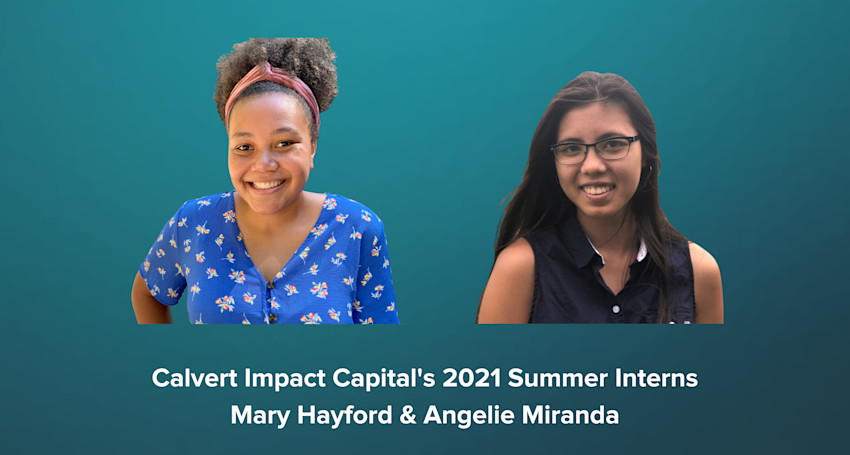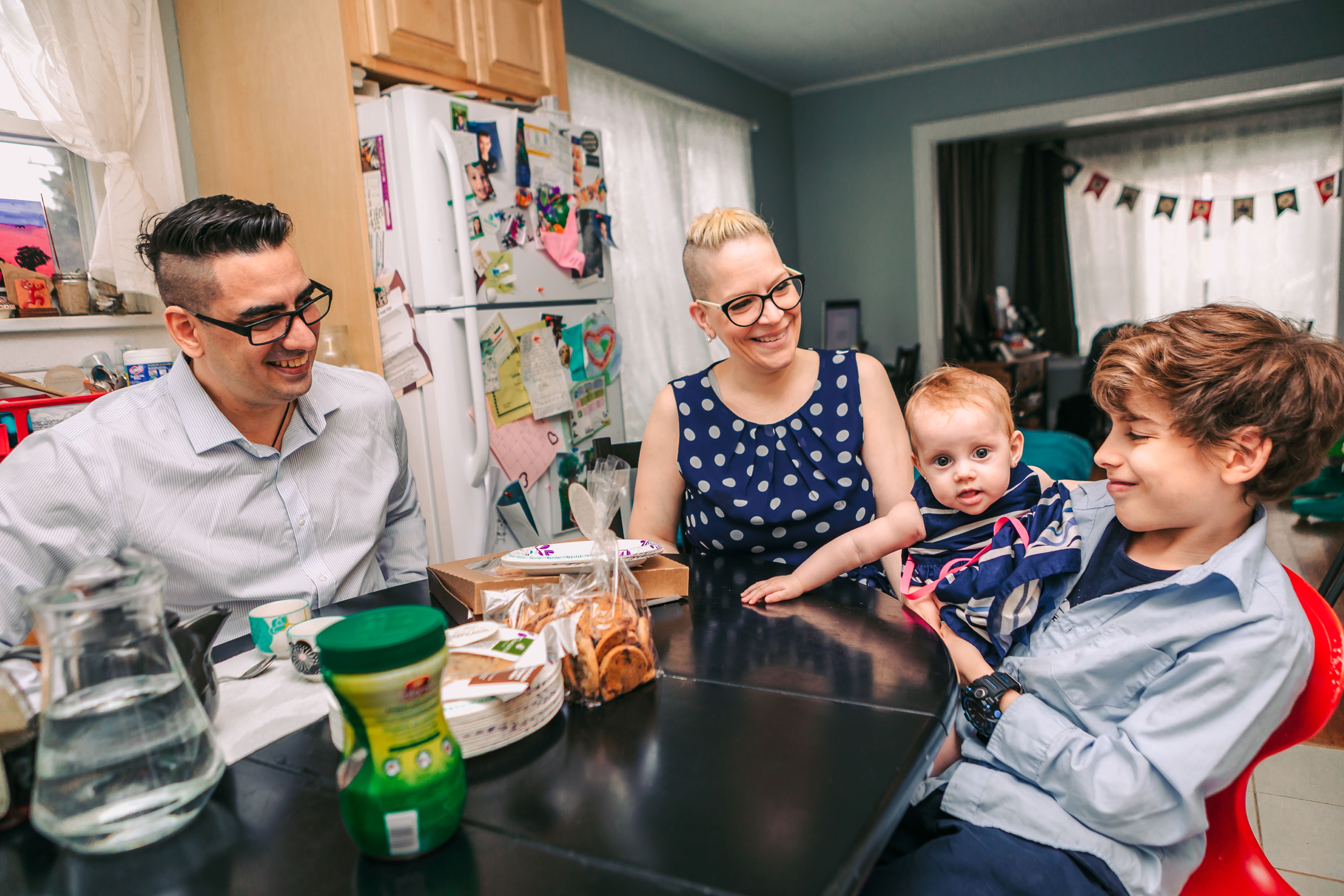
Capital Can Create Meaningful Change: Our summer internship experience
November 30, 2021
Editor's Note: This summer we hosted interns Mary Hayford and Angelie Miranda, both students at the University of Chicago who worked on portfolio, policy, and impact-related projects for their internships. As their internships end, they discuss their work at Calvert Impact Capital and their impressions of the broader impact investing industry through the lens of their main projects.
Mary: I'm an incoming fourth-year at the University of Chicago majoring in Economics and Public Policy. This summer, I've been working on a few different projects related to measuring and communicating the social and environmental impact of Calvert Impact Capital’s portfolio. One of the major projects Calvert Impact Capital engages on each summer is gathering impact data, stories, and photos from each portfolio partner to track the progress of borrowers in reaching their social and environmental impact goals and to showcase these stories of impact in the annual impact report. I've been helping the team process and analyze the quantitative impact data received from portfolio partners, which has been a great way to gain familiarity with Calvert Impact Capital’s portfolio. Throughout the summer, I’ve also been conducting a portfolio analysis of borrower’s gender strategies, updating the portfolio partner profiles using the new photos and stories they’ve sent us, and helping develop content for Calvert Impact Capital’s new website [which launched in October 2021].
Angelie: I also attend the University of Chicago, as a rising second-year, and I am majoring in Statistics, which lead me to working with Calvert Impact Capital’s Risk team. I’ve been doing data gathering and analysis to help the team update portfolio risk and country risk models. I have also been helping the Strategy and Syndications team with researching the Bipartisan Infrastructure Bill.
Mary: It’s great that you’ve been able to use your statistics knowledge to help with updating the risk models. Can you explain how the risk models are used at Calvert Impact Capital?
Angelie: The risk models help Calvert Impact Capital adequately assess the financial risk of each loan and investment they make. Accuracy in these models is especially important because overestimating the risks of impact investing is one of the key issues keeping the field from growing faster and reaching its full potential.
Mary: In addition to the work the Risk team does to evaluate the financial risks of an investment through the risk model, Calvert Impact Capital also utilizes an impact model -- called the Impact Scorecard -- to evaluate a loan’s potential impact. The Impact Scorecard looks at how the portfolio partner’s mission relates to Calvert Impact Capital's theory of change, the demographic groups the organization targets, and a variety of other metrics to assess expected social and environmental outcomes. After an investment is made, they collect impact data each year to identify the environmental and social returns on investments.
Angelie: Other than getting data ready for the annual impact report, how else have you been using the impact data submitted by portfolio partners this summer?
Mary: I’ve been using the impact data to examine the gender diversity of Calvert Impact Capital borrowers’ boards, senior leadership, staff, and clients and I have also been researching borrowers' strategies and programs to improve the lives of women and girls. You also conducted some research this summer, right Angelie?
Angelie: Yes, I did a bit of research into the funding priorities of the Infrastructure bill and what impact it might have on some key sectors Calvert Impact Capital lends to. It was interesting to explore impact investing from a policy angle. Mary, you have also been working on updating content for Calvert Impact Capital's website, right?
Mary: Yes, I have been helping create content for a new page dedicated to highlighting how CIC’s investments directly contribute to the UN’s Sustainable Development Goals (SDGs). For this project, I relied on the impact data to compile portfolio level statistics relevant to each SDG such as the number of new student seats in schools financed by portfolio partners’ capital for SDG 5: Quality Education, or the amount of energy conserved due to building efficiency upgrades for SDG 9: Industry, Innovation, and Infrastructure.
It's been interesting to learn more about portfolio partners through the lens of the SDGs. Angelie, have you been able to learn more about any portfolio partners in particular through your work this summer?
Angelie: I had the opportunity to shadow risk officers on a few deals, including a renewal with an affordable housing borrower who Calvert Impact Capital has been working with since 1999: Self-Help Enterprises (SHE). Based in the San Joaquin Valley of California, SHE helps members of their community access affordable housing through services such as down payment assistance, homeownership education, and a build-your-own-home program, among other community development programs. This past August, SHE and their partner Sunrun, a leader in providing residential solar panels and home batteries, celebrated the completion of their first Solar on Multifamily Affordable Housing (SOMAH) project, which enabled 60 affordable home renters to have access to solar power, helping them cut their monthly energy bills by almost $50. The SOMAH projects provide paid training for jobs in the clean energy field in addition to installing solar panels, in line with Self-Help Enterprise’s philosophy of providing the right tools to empower low-income families to improve their own living conditions. To learn more about SHE, and the impact of other borrowers in affordable housing, you can check out this page.
Mary, did any portfolio partners stand out to you in any of your projects?
Mary: Yes, I've been helping to update the portfolio partner profiles with new photos and stories that highlight the incredible impact they have made recently. One of my favorite new impact stories came from Community Asset Preservation Corporation (CAPC), a nonprofit organization that focuses on creating affordable housing opportunities to meet the needs of individuals and families in New Jersey, particularly after Hurricane Sandy hit in 2012. Monica and Manuel’s family previously lived in San Juan, Puerto Rico, but moved to New Jersey because of financial trouble and neighborhood violence close to their previous home. After several years of living in a small apartment, the growing family sought the help of a grant from CAPC’s Down Payment Assistance to purchase a home. Today, their son Lucas and his baby sister Mila love having a backyard and participating in neighborhood activities. I love this story because it illustrates how the help of Calvert Impact Capital’s borrowers’ capital and services can make long-lasting positive impacts on families. You can read more about Monica and Manuel’s family on CAPC’s Portfolio Page.

Angelie: That’s a great story! It really highlights how Calvert Impact Capital’s portfolio partners support communities. What are some of the biggest things you’ll take away from this internship?
Mary: Interning at Calvert Impact Capital has been an amazing opportunity; I’m very grateful that I got to spend the summer learning from all the welcoming and helpful people who make Calvert Impact Capital so great. I’ve learned so much about the impact investing industry and the work of Calvert Impact Capital’s portfolio partners this summer. Working closely with the impact data in several of my projects has been a great opportunity to learn more about the variety of ways that the financial industry can create meaningful change that improves the lives of communities and contributes to environmental sustainability.
What about you Angelie? What are the biggest takeaways from your internship?
Angelie: I am greatly appreciative of Calvert Impact Capital’s collaborative and inviting work culture, especially with this being my introduction to interning and being in the workforce. I had plenty of opportunities to learn about the other teams that make up Calvert Impact Capital, and everyone I talked with was willing to share their insights on impact investing or help me understand more about portfolio partners. Before working here, I had no knowledge of impact investing and the potential that capital has in this context; this summer has given me the chance to explore a field I may not have otherwise considered.
Thank you to both Angelie and Mary for their hard work this summer!




